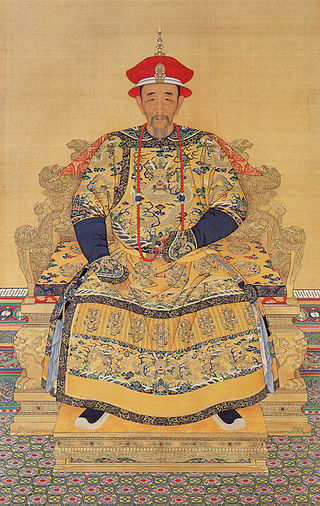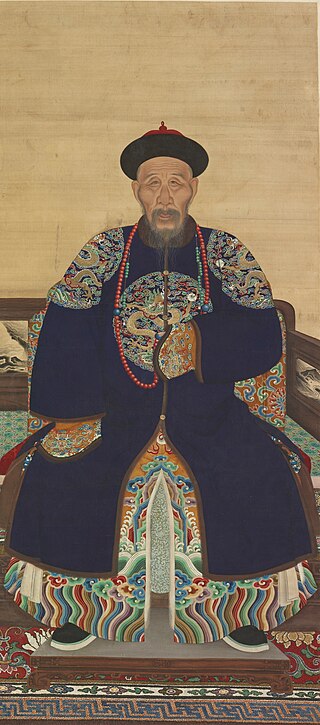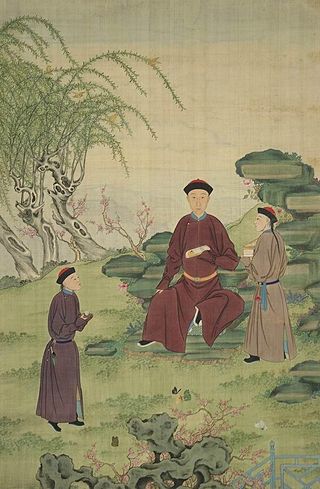
The Kangxi Emperor, also known by his temple name Emperor Shengzu of Qing, born Xuanye, was the third emperor of the Qing dynasty, and the second Qing emperor to rule over China proper, reigning from 1661 to 1722.

The Xianfeng Emperor, or by temple name Emperor Wenzong of Qing (清文宗), given name Yizhu (奕詝), was the eighth Emperor of the Qing dynasty, and the seventh Qing emperor to rule over China proper, reigned from 1850 to 1861. During his reign, the Qing dynasty experienced several wars and rebellions including the Taiping Rebellion, Nian Rebellion, and Second Opium War. He was the last Chinese emperor to have authoritarian and total executive ruling power. After his death, the Qing government was controlled by Empress Dowager Cixi.

The Daoguang Emperor, also known by his temple name Emperor Xuanzong of Qing, born Mianning, was the seventh Emperor of the Qing dynasty, and the sixth Qing emperor to rule over China proper, reigning from 1820 to 1850. His reign was marked by "external disaster and internal rebellion." These included the First Opium War and the beginning of the Taiping Rebellion which nearly brought down the dynasty. The historian Jonathan Spence characterizes the Daoguang Emperor as a "well meaning but ineffective man" who promoted officials who "presented a purist view even if they had nothing to say about the domestic and foreign problems surrounding the dynasty."

The Jiaqing Emperor, also known by his temple name Emperor Renzong of Qing, born Yongyan, was the sixth emperor of the Manchu-led Qing dynasty, and the fifth Qing emperor to rule over China proper, from 1796 to 1820. He was the 15th son of the Qianlong Emperor. During his reign, he prosecuted Heshen, the corrupt Manchu favorite of his father, and attempted to restore order within the Qing Empire while curbing the smuggling of opium into China.

The Qianlong Emperor, also known by his temple name Emperor Gaozong of Qing, born Hongli, was the fifth emperor of the Qing dynasty and the fourth Qing emperor to rule over China proper, reigning from 1735 to 1796. The fourth son of the Yongzheng Emperor, he reigned officially from 11 October 1735 to 8 February 1796. In 1796, he abdicated in favour of his son, the Jiaqing Emperor, out of filial piety towards his grandfather, the Kangxi Emperor, who ruled for 61 years, so that he not officially usurp him as the longest-reigning emperor. Despite his retirement, however, the Qianlong Emperor retained ultimate power as the Emperor Emeritus until his death in 1799, making him one of the longest-reigning monarchs in history, and dying at the age of 87, one of the longest-lived.

Yunti, born Yinzhen and also known as Yinti before 1722, formally known as Prince Xun, was a Manchu prince and military general of the Qing dynasty.

Yunreng, born Yinreng, was a Manchu prince of the Qing dynasty. He was the second among the Kangxi Emperor's sons to survive into adulthood and was designated as Crown Prince for two terms between 1675 and 1712 before being deposed. He was posthumously honoured as Prince Limi of the First Rank.

The Wanli Emperor, personal name Zhu Yijun, was the 14th Emperor of the Ming dynasty, reigned from 1572 to 1620. "Wanli", the era name of his reign, literally means "ten thousand calendars". He was the third son of the Longqing Emperor. His reign of 48 years (1572–1620) was the longest among all the Ming dynasty emperors and it witnessed several successes in his early and middle reign, followed by the decline of the dynasty as the emperor withdrew from his active role in government around 1600.

Yixin, better known in English as Prince Kung or Gong, was an imperial prince of the Aisin Gioro clan and an important statesman of the Manchu-led Qing dynasty in China. He was a regent of the empire from 1861 to 1865 and wielded great influence at other times as well.

Yixuan, formally known as Prince Chun, was an imperial prince of the House of Aisin-Gioro and a statesman of the Manchu-led Qing dynasty in China. He was the father of the Guangxu Emperor, and the paternal grandfather of Puyi through his fifth son Zaifeng.

Jerjer, of the Khorchin Mongol Borjigit clan, was the consort of Hong Taiji. She was seven years his junior. Jerjer was Empress consort of Qing from 1636 until her husband's death in 1643, after which she was known as Empress dowager. She was posthumously honoured with the title Empress Xiaoduanwen.

Hongzhou, formally known as Prince He, was a Manchu prince of the Qing dynasty.
The ranks of imperial consorts have varied over the course of Chinese history but remained important throughout owing to its importance in management of the inner court and in imperial succession, which ranked heirs according to the prominence of their mothers in addition to their strict birth order. Regardless of the age, however, it is common in English translation to simplify these hierarchy into the three ranks of Empress, consorts, and concubines. It is also common to use the term "harem", an Arabic loan word used in recent times to refer to imperial women's forbidden quarters in many countries. In later Chinese dynasties, these quarters were known as the back palace. In Chinese, the system is called the Rear Palace System.
Succession War is Hong Kong historical drama created and produced by Chong Wai-kin for TVB, starring Ruco Chan, Shaun Tam, Selena Lee, Natalie Tong and Elaine Yiu as the main leads. The show is a fictional biography story about the last 28 days of the life of Qing dynasty court official Heshen, who is known for being the most corrupt court official in Chinese history. Succession War premiered on 25 June 2018 on TVB Jade.
Imperial Noble Consort Chunque, from the Han Chinese Geng clan, was a consort of Yongzheng Emperor.
The Jiaqing Emperor had a total number of 14 consorts, including 2 empresses, 2 imperial noble consorts, 4 consorts and 6 concubines.
Aisin Gioro Yunki, born Yinqi and formally known as Prince Heng of the First Rank, was an imperial prince of the Manchu ruled Qing Dynasty. He was the fifth son of Kangxi Emperor who survived to adulthood.
Aisin Gioro Yunbi, born Yinbi, formally known by his title as Prince Xian (𫍯王), was an imperial prince of the Qing Dynasty and the 24th surviving son of the Kangxi Emperor.
Namjung of the Abaga Borjigit clan, formally known as Noble Consort Yijing (懿靖貴妃), was the wife of Ligdan Khan, who after his death became a concubine of Hong Taiji.

Empress Xiaohui, of the Shao clan, was a consort of the Chenghua Emperor.












